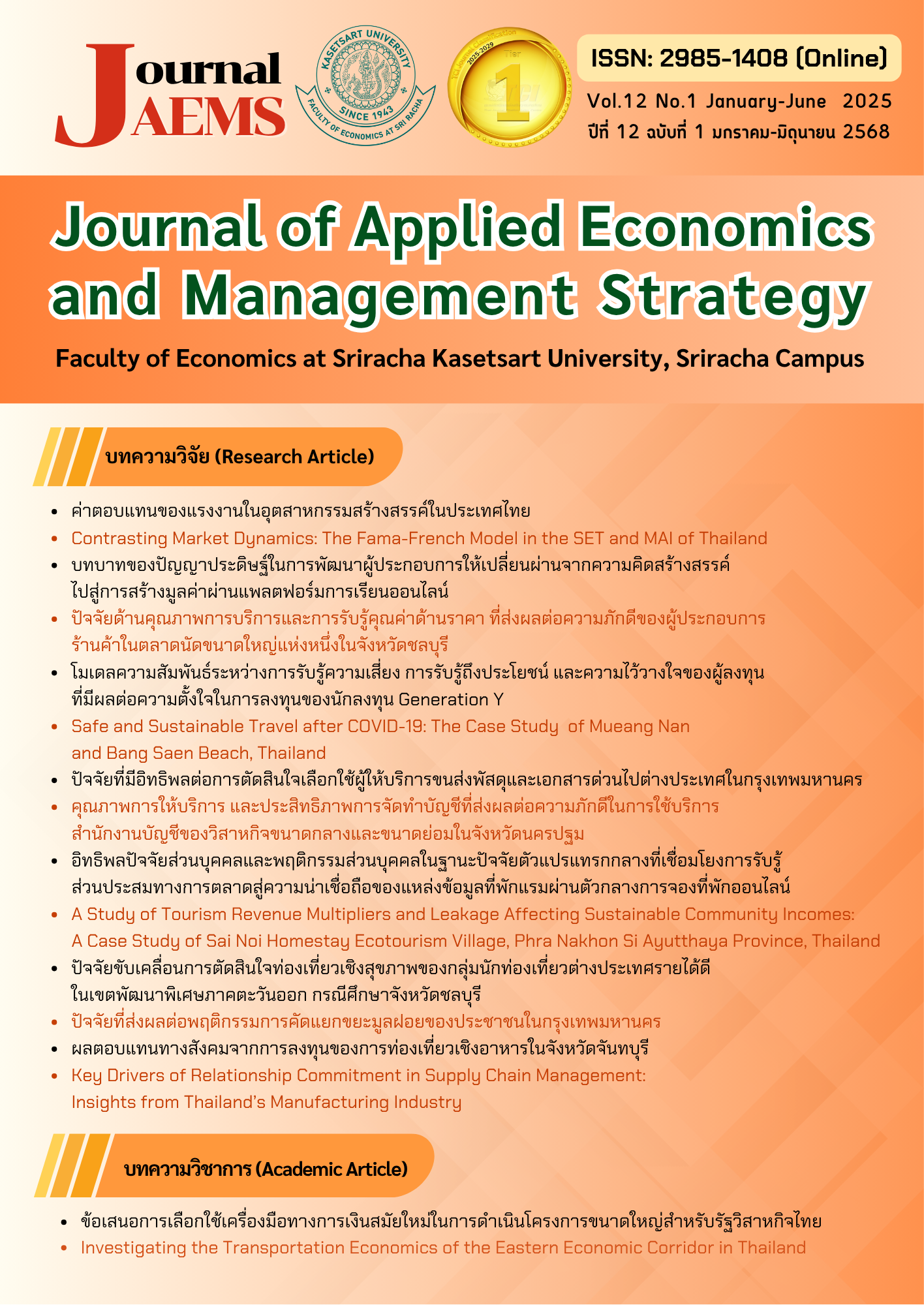Driving Factors Influencing International Affluent Tourists' Decision in Wellness Tourism in the Eastern Economic Corridor: A Case Study of Chonburi Province
Main Article Content
Abstract
Wellness tourism is one of the fastest-growing trends in the tourism industry, as people increasingly prioritize health and quality of life. Thailand is a prominent country in wellness tourism, particularly in Southeast Asia, due to its rich natural resources, unique cultural heritage, and high-quality medical services at competitive prices. Chonburi Province, renowned for its tourist attractions, not only boasts stunning beaches and diverse travel destinations but also provides comprehensive health services. This research aims to examine the push and pull motivations of high-income tourists influencing their decision to engage in health tourism in Chonburi. The findings will serve as a guideline for effectively planning the development of health tourism to better meet the needs of international high-income tourists. Push motivation refers to intrinsic factors that stimulate individuals to undertake travel, whereas pull motivation pertains to external attributes of a destination that attract travelers in response to their internal drives. This study employed a quantitative research approach, utilizing a survey questionnaire to collect data from 356 high-income international tourists visiting Chonburi for health tourism with sampling method applied as Quota Sampling. The data were analyzed using descriptive statistics, One-Way ANOVA to examine mean differences, paired comparisons with LSD, and multiple linear regression analysis. The results revealed that age, education, occupation, income, and nationality significantly influenced the motivations of affluent tourists participating in wellness tourism. Furthermore, both push and pull factors positively impacted the decision-making process of affluent international tourists in choosing Chonburi as a wellness tourism destination.
Downloads
Article Details

This work is licensed under a Creative Commons Attribution-NonCommercial-NoDerivatives 4.0 International License.
References
กรมการแพทย์แผนไทยและการแพทย์ทางเลือก. (2566). ไทยเดินหน้ารับรองศูนย์เวลเนส (Wellness Center) สร้างมาตรฐานรองรับตลาดท่องเที่ยวเพื่อสุขภาพ. สืบค้นเมื่อ 12 มกราคม 2568, จาก https://www.thailand.go.th/issue-focus-detail/001_07_032
กรัณย์ ปัญโญ (2563). การศึกษาศักยภาพการท่องเที่ยวเชิงสุขภาพของสนามกอล์ฟในการให้บริการนักท่องเที่ยวชาวต่างชาติเขตภาคเหนือตอนบน. วารสารวิชาการมหาวิทยาลัยการกีฬาแห่งชาติ, 12(1), 175-187.
การท่องเที่ยวแห่งประเทศไทย. (2566). การท่องเที่ยวหรืออุตสาหกรรมท่องเที่ยวเป็นเรื่องใกล้ตัวกว่าที่คิดการท่องเที่ยวแห่งประเทศไทย.ชลบุรี. สืบค้นเมื่อ 9 มกราคม 2568, จาก https://tatreviewmagazine.com/article/community-based-tourism/
การท่องเที่ยวแห่งประเทศไทย. (2567). นโยบายส่งเสริมแพทย์แผนไทยและสมุนไพร: ซอฟต์พาวเวอร์เพื่อพัฒนาการท่องเที่ยวเชิงสุขภาพ. สืบค้นเมื่อ 4 มกราคม 2568, จากhttps://datacatalog.tat.or.th/en/group/policy
นฤมล จันทร์มา. (2565). ศักยภาพและความต้องการของตลาดในการท่องเที่ยวเชิงสุขภาพจากน้ำพุร้อน จังหวัด เพชรบูรณ์. วารสารวิทยาศาสตร์และเทคโนโลยี มหาวิทยาลัยราชภัฏเชียงราย, 1(1), 40-56.
รัศมีพร พยุงพงษ์ และเจกิตาน์ ศรีสรวล. (2566). พฤติกรรมการท่องเที่ยววิถีใหม่อย่างรับผิดชอบของนักท่องนักเที่ยวชาวไทยในแหล่งท่องเที่ยวชายหาดบางแสนจังหวัดชลบุรี. วารสารวิชาการศรีปทุมชลบุรี, 20(1), 24-33.
ลลิตา เลิศส่องแสง. (2565). ผลกระทบของค่านิยมที่มีผลต่อแรงจูงใจและความตั้งใจเชิงพฤติกรรมในการท่องเที่ยวคนเดียวของผู้หญิงไทยที่พักอาศัย ในเขตกรุงเทพมหานคร. (วิทยานิพนธ์ปริญญามหาบัณฑิต, มหาวิทยาลัยมหิดล).
เสาวลักษณ์ ใจหล้า. (2567). แรงจูงใจในการเดินทางท่องเที่ยวของ นักท่องเที่ยวกลุ่มเจเนอเรชัน Y ในจังหวัดนครสวรรค์จากสื่อออนไลน์. นวัตศาสตร์สหวิทยาการ, 2(3), 62-79.
Azman, I., & Chan, K. L. J. (2010). Health and spa tourism business: Tourists’ profiles and motivational factors. In Health, wellness and tourism: Healthy tourists, healthy business? Proceedings of the Travel and Tourism Research Association Europe 2010 Conference (pp. 9–24). Budapest, Hungary.
Chanma, N. (2022). Potential and market demand for health tourism from hot springs in Phetchabun Province. Journal of Science and Technology Chiang Rai Rajabhat University, 1(1), 40–56. (in Thai)
Cochran, S. (1977). Sampling techniques. Hoboken, NJ: John Wiley & Sons, Inc.
Damijanić, A. T. (2020). Travel motivations as criteria in the wellness tourism market segmentation process. Academica Turistica–Tourism and Innovation Journal, 13(2), 201–213.
Department of Thai Traditional and Alternative Medicine. (2023). Thailand advances the certification of Wellness Centers to establish standards for health tourism markets. Retrieved January 12, 2025, from https://www.thailand.go.th/issue-focus-detail/001_07_032. (in Thai)
Gan, T., Zheng, J., Li, W., Li, J., & Shen, J. (2023). Health and wellness tourists’ motivation and behavior intention: The role of perceived value. International Journal of Environmental Research and Public Health, 20(5), 4339.
Global Wellness Institute. (2025). Global wellness economy: Looking beyond COVID-19. Retrieved January 19, 2025, from https://globalwellnessinstitute.org.
Jailar, S. (2024). Travel Motivation of Generation Y Tourists in Nakhon Sawan Province Through Online Media. Nawatsart Interdisciplinary Journal, 2(3), 62-79. (in Thai)
Lertsongsaeng, L. (2022). The impact of values on motivation and behavioral intentions in solo travel by Thai women residing in Bangkok (Master Independent Study). Mahidol University. (in Thai)
Ministry of Tourism and Sports. (2567). Statistical report of Chonburi province: Tourism revenue in 2023. Office of Chonburi Provincial Statistics. Retrieved January 9, 2025, from https://chonburi.nso.go.th/statistical-information-service/key-indicators-of-the-province.html
Nunnally, J. C. (1978). Psychometric Theory. McGraw-Hill Book Company, pp. 86-113, 190-255.
Office of Chonburi Tourism and Sports. (2024). Tourist attractions and activities in Chonburi province. Retrieved from http://www.chonburimots.go.th/th/
Panyo, K. (2020). A study of the health tourism potential of golf courses in serving foreign tourists in the upper northern region. Journal of National Sports University, 12(1), 175–187. (in Thai)
Payungpong, R., & Srisuan, J. (2023). Responsible new normal tourism behavior of Thai tourists at Bang Saen Beach, Chonburi Province. Journal of Sripatum University Chonburi, 20(1), 24–33. (in Thai)
Pinthong, C., & Pongwat A. (2022). Exploring the Service Quality Factors of Spa Business in Pattaya, Thailand. Burapha Journal of Business Management, Burapha University, 11(1), 109-131.
Rovinelli, R.J., & Hambleton, R.K. (1977). On the use of content specialists in the assessment of criterion-referenced test item validity. Dutch Journal of Educational Research, 2, 49-60.
Silva, L., Breda, Z., Brandão, F., Costa, R. (2021). #ITravelSolo: Women Solo Travellers. Smart Innovation, Systems and Technologies, 209, 624-636. DOI 10.1007/978-981-33-4260-6_53.
Tourism Authority of Thailand. (2023). Tourism or the tourism industry is closer to home than you think: Tourism Authority of Thailand. Chonburi. Retrieved January 9, 2025, from https://tatreviewmagazine.com/article/community-based-tourism. (in Thai).
Tourism Authority of Thailand. (2024). Policy to promote Thai traditional medicine and herbal remedies: Soft power for the development of health tourism. Retrieved January 4, 2025, from https://datacatalog.tat.or.th/en/group/policy. (in Thai)
Unesco. (2020). Thai Massage: A Cultural Heritage of Humanity. Retrieved January 19, 2025, from https://ich.unesco.org
